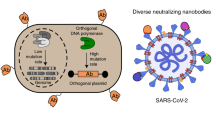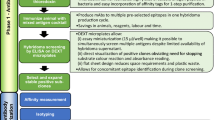Abstract
Antibodies are important tools for investigating the proteome, but current methods for producing them have become a rate-limiting step1. A primary obstacle in most methods for generating antibodies or antibody-like molecules is the requirement for at least microgram quantities of purified protein. We have developed a technology for producing antibodies using genetic immunization2. Genetic immunization–based antibody production offers several advantages, including high throughput3 and high specificity. Moreover, antibodies produced from genetically immunized animals are more likely to recognize the native protein2. Here we show that a genetic immunization–based system can be used to efficiently raise useful antibodies to a wide range of antigens. We accomplished this by linking the antigen gene to various elements that enhance antigenicity and by codelivering plasmids encoding genetic adjuvants. Our system, which was tested by immunizing mice with >130 antigens, has shown a final success rate of 84%.
This is a preview of subscription content, access via your institution
Access options
Subscribe to this journal
Receive 12 print issues and online access
$209.00 per year
only $17.42 per issue
Buy this article
- Purchase on Springer Link
- Instant access to full article PDF
Prices may be subject to local taxes which are calculated during checkout



Similar content being viewed by others
References
Kodadek, T. Protein microarrays: prospects and problems. Chem. Biol. 8, 105–115 (2001).
Tang, D.-C., DeVit, M. & Johnston, S.A. Genetic immunization is a simple method for eliciting an immune response. Nature 356, 152–154 (1992).
Sykes, K.F. & Johnston, S.A. Linear expression elements: a rapid, in vivo, method to screen for gene functions. Nat. Biotechnol. 17, 355–359 (1999).
Babiuk, L.A., van Drunen Littel-van den Hurk, S. & Babiuk, S.L. Immunization of animals: from DNA to the dinner plate. Vet. Immunol. Immunopathol. 72, 189–202 (1999).
Svanholm, C., Bandholtz, L., Lobell, A. & Wigzell, H. Enhancement of antibody responses by DNA immunization using expression vectors mediating efficient antigen secretion. J. Immunol. Methods 228, 121–130 (1999).
Li, Z. et al. Immunogenicity of DNA vaccines expressing tuberculosis proteins fused to tissue plasminogen activator signal sequences. Infect. Immun. 67, 4780–4786 (1999).
Hammond, C. & Helenius, A. Quality control in the secretory pathway. Curr. Opin. Cell Biol. 7, 523–529 (1995).
Terskikh, A.V. et al. “Peptabody”: a new type of high-avidity binding protein. Proc. Natl. Acad. Sci. USA 94, 1663–1668 (1997).
St. Clair, N., Shenoy, B., Jacob, L.D. & Margolin, A.L. Cross-linked protein crystals for vaccine delivery. Proc. Natl. Acad. Sci. USA 96, 9469–9474 (1999).
Valenzuela, P., Medina, A., Rutter, W.J., Ammerer, G. & Hall, B.D. Synthesis and assembly of hepatitis B virus surface antigen particles in yeast. Nature 298, 347–350 (1982).
Scheerlinck, J.-P.Y. Genetic adjuvants for DNA vaccines. Vaccine 19, 2647–2656 (2001).
Antonysamy, M.A. & Thomson, A.W. Flt3 ligand (FL) and its influence on immune reactivity. Cytokine 12, 87–100 (2000).
International Human Genome Sequencing Consortium. Initial sequencing and analysis of the human genome. Nature 409, 860–921 (2001).
Andre, S. et al. Increased immune response elicited by DNA vaccination with a synthetic gp120 sequence with optimized codon usage. J. Virol. 72, 1497–1503 (1998).
Stratford, R. et al. Influence of codon usage on the immunogenicity of a DNA vaccine against tetanus. Vaccine 19, 810–815 (2001).
Smith, C., Day, P.J.R. & Walker, M.R. Generation of cohesive ends on PCR products by UDG-mediated excision of dU, and application for cloning into restriction digest-linearized vectors. PCR Methods Appl. 2, 328–332 (1993).
Zinkernagel, R.M. What is missing in immunology to understand immunity? Nat. Immunol. 1, 181–185 (2000).
King, C.A. et al. DNA vaccines with single-chain Fv fused to fragment C of tetanus toxin induce protective immunity against lymphoma and myeloma. Nat. Med. 4, 1281–1286 (1998).
Dalum, I., Jensen, M.R., Hindersson, P., Elsner, H.I. & Mouritsen, S. Breaking of B cell tolerance toward a highly conserved self protein. J. Immunol. 157, 4796–4804 (1996).
Jameson, B.A. & Wolf, H. The antigenic index: a novel algorithm for predicting antigenic determinants. Comput. Appl. Biosci. 4, 181–186 (1988).
Pizza, M. et al. Identification of vaccine candidates against serotype B Meningococcus by whole-genome sequencing. Science 287, 1816–1820 (2000).
Field, C.M., Oegema, K., Zheng, Y., Mitchison, T.J. & Walczak, C.E. Purification of cytoskeletal proteins using peptide antibodies. Methods Enzymol. 298, 525–541 (1998).
Braun, P. et al. Proteome-scale purification of human proteins from bacteria. Proc. Natl. Acad. Sci. USA 99, 2654–2659 (2002).
Barry, M.A., Barry, M.E. & Johnston, S.A. Production of monoclonal antibodies by genetic immunization. Biotechniques 16, 616–619 (1994).
Chowdhury, P.S., Viner, J.L., Beers, R. & Pastan, I. Isolation of a high-affinity stable single-chain Fv specific for mesothelin from DNA-immunized mice by phage display and construction of a recombinant immunotoxin with anti-tumor activity. Proc. Natl. Acad. Sci. USA 95, 669–674 (1998).
Niwa, H., Yamamura, K. & Miyazaki, J. Efficient selection for high-expression transfectants with a novel eukaryotic vector. Gene 108, 193–199 (1991).
Chang, C. et al. The Gal4 activation domain binds sug2 protein, a proteosome component, in vivo and in vitro. J. Biol. Chem. 276, 30956–30963 (2001).
Sykes, K.F. & Johnston, S.A. Genetic live vaccines mimic the antigenicity but not pathogenicity of live viruses. DNA Cell Biol. 18, 521–531 (1999).
Stemmer, W.P.C., Crameri, A., Ha, K.D., Brennan, T.M. & Heyneker, H.L. Single-step assembly of a gene and entire plasmid from large numbers of oligodeoxyribonucleotides. Gene 164, 49–53 (1995).
Acknowledgements
We thank Ryan Anholt, Anwarul Ferdous, Kyle Meinert, Joey Nguyen, Vickie Seward, Rebecca Solis and Greg Urquhart for technical assistance, Mike McGuire, Bao-Xi Qu and Irene Rombel for helpful discussions and Rick Lyons for supplying the Mtb extracts. This work was supported by grants from the Programs for Genomic Applications (PGA) from the US National Heart, Lung, and Blood Institute to S.A.J. at the University of Texas Southwestern (U01HL66880), and from the Countermeasures Program from the University of Texas Austin.
Author information
Authors and Affiliations
Corresponding author
Ethics declarations
Competing interests
The authors declare no competing financial interests.
Rights and permissions
About this article
Cite this article
Chambers, R., Johnston, S. High-level generation of polyclonal antibodies by genetic immunization. Nat Biotechnol 21, 1088–1092 (2003). https://doi.org/10.1038/nbt858
Received:
Accepted:
Published:
Issue Date:
DOI: https://doi.org/10.1038/nbt858
This article is cited by
-
BrainPhys neuronal medium optimized for imaging and optogenetics in vitro
Nature Communications (2020)
-
RNA Transcription and Splicing Errors as a Source of Cancer Frameshift Neoantigens for Vaccines
Scientific Reports (2019)
-
The preclinical evaluation of immunocontraceptive vaccines based on canine zona pellucida 3 (cZP3) in a mouse model
Reproductive Biology and Endocrinology (2018)
-
Using Frameshift Peptide Arrays for Cancer Neo-Antigens Screening
Scientific Reports (2018)
-
A Novel Molecular Design for a Hybrid Phage-DNA Construct Against DKK1
Molecular Biotechnology (2018)



